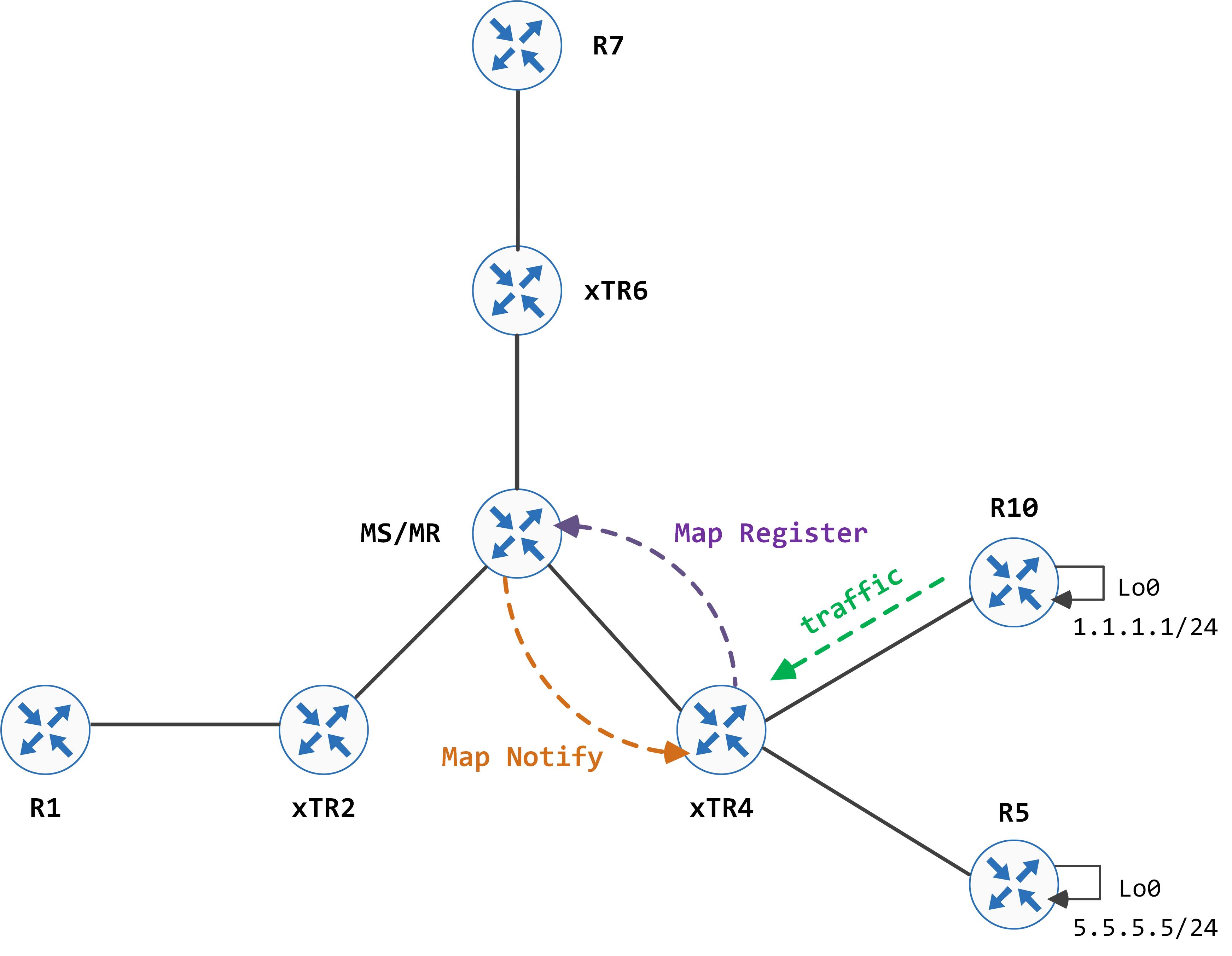Cisco SDA Part V - LISP mobility - roaming hosts
In this post, we look at an actual LISP host mobility event and what happens behind the scenes to make this work.
Introduction and topology
Continuing on from the previous post, we take a look at actual host mobility events and how the LISP infrastructure facilitates this. Our goal for this post is to have the simulated host (1.1.1.1) move from behind xTR2 to behind xTR4 (simulated via R10). A working assumption used in the post is that there is no active traffic destined for the host that is moving (we will look at this in the SMR post).
The topology is a slightly modified version of what we used in the last post:

There are certain baselines we need to establish from the get go - 1.1.1.1/32 has been learnt dynamically and installed in the site database of the MS/MR, with a RLOC of xTR2 (2.2.2.2). Let's confirm this:
MS_MR#show lisp site 1.1.1.1
LISP Site Registration Information
Site name: SITE_A
Allowed configured locators: any
Requested EID-prefix:
EID-prefix: 1.1.1.1/32
First registered: 00:19:38
Last registered: 00:00:56
Routing table tag: 0
Origin: Dynamic, more specific of 1.1.1.0/24
Merge active: No
Proxy reply: No
TTL: 1d00h
State: complete
Registration errors:
Authentication failures: 0
Allowed locators mismatch: 0
ETR 2.2.2.2, last registered 00:00:56, no proxy-reply, map-notify
TTL 1d00h, no merge, hash-function sha1, nonce 0xC6805C87-0xF287CBA7
state complete, no security-capability
xTR-ID 0x8527C2E3-0xB036F499-0x0C2893BB-0x56D43540
site-ID unspecified
Locator Local State Pri/Wgt Scope
2.2.2.2 yes up 0/0 IPv4 none
On xTR2, this entry is also present in its LISP database:
xTR2#show ip lisp database
LISP ETR IPv4 Mapping Database for EID-table default (IID 0), LSBs: 0x1, 1 entries
1.1.1.1/32, dynamic-eid 1.1.1.0/24_EID, locator-set xTR2
Locator Pri/Wgt Source State
2.2.2.2 0/0 cfg-intf site-self, reachable
Additionally, xTR4 needs to be provisioned for 1.1.1.0/24 as a dynamic EID:
xTR4(config)#router lisp
xTR4(config-router-lisp)#eid-table default instance-id 0
xTR4(config-router-lisp-eid-table)#dynamic-eid 1.1.1.0/24_EID
xTR4(config-router-lisp-eid-table-dynamic-eid)#database-mapping 1.1.1.0/24 locator-set xTR4
LISP mobility event
So, now that we have these baselines established, let's move 1.1.1.1 to R10.

When this happens, some traffic (can be control-plane or data-plane) is generated from 1.1.1.1 and it hits xTR4. xTR4 dynamically learns this, installs it in its LISP database and sends a Map Register to the MS/MR. The MS/MR accepts this and installs it in its site database.

At the same time, the MS/MR knew that there was a previously registered RLOC against this specific /32 entry. It informs the original RLOC (xTR2, in this case) of this new RLOC learn by sending it a Map Notify as well.

This Map Notify is as follows:

When xTR2 receives this Map Notify, it realizes that the host has "moved away". It deletes the /32 entry from its LISP database and sends a Map Register back to the MS/MR with an action of 'Drop'.

This packet looks like so:

On receiving this Map Register, the MS/MR removes xTR2 as a RLOC for 1.1.1.1/32. This action completes the host move.
